#digital voltmeter
Text
Enhance Efficiency and Flexibility with DIN Rail Mounted Terminal Blocks in India
Introduction:
In today's rapidly evolving industrial landscape, efficient and reliable electrical connections are crucial for ensuring smooth operations. DIN rail mounted terminal blocks have emerged as a preferred solution for creating secure and organized electrical connections in a wide range of applications. With their versatility, durability, and ease of installation, these terminal blocks have gained immense popularity among professionals in India. In this blog post, we will explore the benefits and applications of rail mounted terminal blocks and highlight their importance in the Indian industrial sector.

What are DIN Rail Mounted Terminal Blocks?
DIN rail mounted terminal blocks are electrical connectors that provide a convenient and standardized method for connecting and distributing power or signals in industrial control systems. These blocks are specifically designed to be mounted on DIN rails, which are widely used for organizing and securing electrical components in control panels, switchgear cabinets, and equipment enclosures.
Benefits of DIN Rail Mounted Terminal Blocks:
Space-saving and Modular Design: DIN rail mounted terminal blocks feature a compact design that allows for optimal use of available space. Their modular construction enables easy customization and expansion as per the specific requirements of an application, making them highly adaptable.
Secure and Reliable Connections: These terminal blocks ensure secure and reliable connections, thanks to their robust construction and advanced connection technologies. They provide a sturdy grip on wires and facilitate excellent contact, minimizing the risk of loose connections and electrical failures.
Easy Installation and Maintenance: With their tool-less and user-friendly design, DIN rail mounted terminal blocks simplify installation and maintenance procedures. The snap-on mounting feature of these blocks allows for quick and hassle-free assembly, reducing overall downtime during system installation or upgrades.
Enhanced Safety: Rail mounted terminal blocks adhere to stringent safety standards and offer features like finger-safe design, which prevents accidental contact with live components. This ensures the safety of both the equipment and the personnel working with them.
Applications of DIN Rail Mounted Terminal Blocks:
Industrial Automation: Rail mounted terminal blocks are extensively used in industrial automation systems, where they serve as a vital component for connecting sensors, actuators, motors, and other devices. These blocks provide a reliable interface for transmitting power and signals between various control elements.
Power Distribution: DIN rail mounted terminal blocks play a crucial role in power distribution systems, allowing for easy and organized connection of power supply lines to different equipment. They enable efficient energy management and facilitate the distribution of power to multiple devices within a control panel.
Building Automation: In building automation systems, DIN rail mounted terminal blocks provide a convenient solution for connecting various electrical components, such as lighting controls, HVAC systems, security systems, and more. Their modular design allows for easy integration and maintenance of these systems.
Rail Mounted Terminal Blocks in India:
The Indian industrial sector is witnessing significant growth, and the demand for reliable electrical connectivity solutions is higher than ever. Rail mounted terminal blocks have gained traction in India due to their versatility and ability to meet the diverse requirements of industries ranging from manufacturing to infrastructure development. Manufacturers and suppliers in India offer a wide range of DIN rail mounted terminal blocks, catering to different voltage and current ratings, wire sizes, and connection types.

Conclusion:
Rail mounted terminal blocks have revolutionized the electrical connectivity landscape in India, providing efficient, secure, and organized solutions for various industrial applications. Their space-saving design, ease of installation, and robust construction make them indispensable for creating reliable connections in control systems and power distribution networks. As the industrial sector continues to thrive in India, the importance of DIN rail mounted terminal blocks as a key component in electrical installations cannot be overstated. By embracing these advanced terminal blocks, Indian industries can enhance efficiency, reduce downtime, and ensure safe and reliable operations.
#Rail Mounted Terminal Blocks India#DIN Rail Mounted Terminal Blocks India#Power BusBar Terminal#Finger Safe Power Terminal blocks#Barrier Terminal Block Manufacturer in India#electrical wire termination technology#manufacturer#terminal block#DIN Rail Mounted Connectors#switchgear industry#solar product#PCB connectors#DIN rails channels#digital voltmeter#digital ammeter#power and signal#current transformer#railway#renewable energy#elmex#electrical company#electrical industry
2 notes
·
View notes
Text
A Complete Guide On Electrical Measuring Instruments

Electrical measuring instruments are essential tools for monitoring, measuring, and analyzing electrical circuits and systems. These instruments play a crucial role in maintaining the safety, accuracy, and efficiency of electrical systems in various industries like construction, manufacturing, and electrical engineering.
This blog will help you to understand the different electrical measuring instruments, their applications and how to use these instruments correctly to get accurate readings.
Multimeter
Multimeters are the most commonly used measuring instruments in laboratories. They can measure multiple electrical quantities like voltage, current, and resistance. Multimeters are often used for troubleshooting and maintenance of electrical systems.
Ammeter
An ammeter measures the direct or alternating current in the electric circuit. The current is measured in Ampere (A). Ammeters are connected in series in the circuit. Ammeter has a very low resistance so as to allow a large amount of current to flow through the circuit. Ammeter can measure a broad range of current values. When the current to be measured is in milliamperes or microamperes, the current is measured in microammeter or milliamperes. There are 2 main types of ammeters – analog and digital. Analog ammeters use a pointer and dial to display the current, while digital ammeters use a digital display.
Voltmeter
Voltmeter measures the voltage or electrical potential difference, between two points in an electrical circuit. Voltage is measured in volts. Voltmeters are typically connected in parallel with the component or circuit being measured, and they have a very high resistance to minimize the amount of current that flows through the circuit. Learn more
0 notes
Text
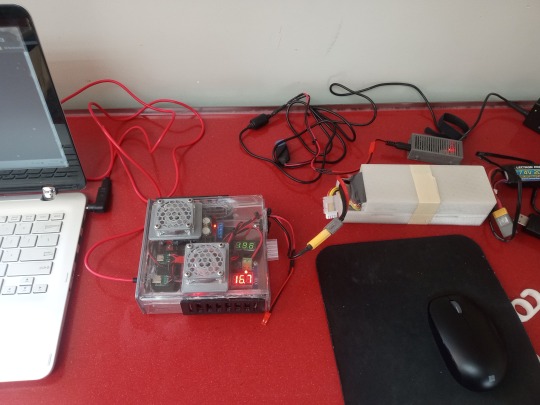
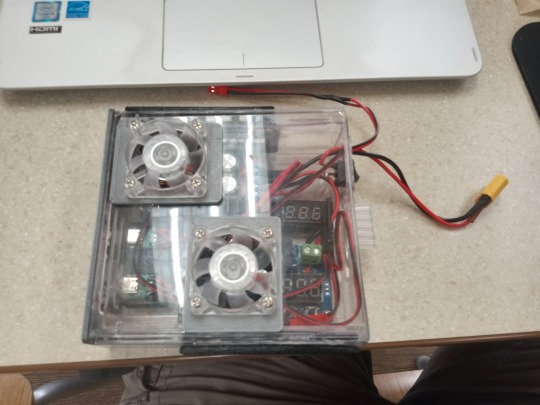

#DC power supplies#this is my first time on this site and this will be my first post I have constructed a DC power supply to charge my laptops by using 150W#to limit the amount of power to what's appropriate to charge the laptop#I also use 0.28 Inch Two-Wire Voltage Meter Micro LED Digital Tube Voltmeter. to allow me to know how much power is coming out of the suppl#40mmx40mmx10mm 2PIN to cool down the DC Boost Converter & the#DC Voltage Protection Module Digital Low Voltage PrLM2596S DC-DC 3A Buck Adjustable Step-down Power Supply Converter Module just otector Di#and also have to design and 3D printed the parts to make everything work properly then I tested this device out and it works perfectly wel#all it all you have to do is to adjusted down to 12v or as much as you charger can handle at this point I got mostly these parts from Ama
0 notes
Text
Writing Scientist Characters
this post is mainly an excuse to post a certain list of lab supplies I've made for a friend and infodump about lab work. but feel free to use this as a little resource when writing characters who are scientists and/or lab nerds. who knows, maybe it'll be of use.
General thoughts
Many people think it's a stereotype that scientist or nerd characters talk using complex technical jargon. While that is true to an extent, there actually is some kind of lab jargon. It varies across different labs and fields, but one thing they have in common is that it seeks to simplify, not the other way around.
gelelectrophoresis becomes elpho
microbiology becomes mibi
deioninized water becomes aqua dist
biochemistry becomes BC
sodium hydroxide becomes NaOH
They will probably not call a glass of water "silicon dioxide and h2o".
...and more. feel free to get creative. If you're writing in any other language than English, you can throw in one or two anglicisms as well. Also, most scientists will never gatekeep their work, and in an opposite fashion, will not shut up about it unless you make them. And no, most chemists do not know the entire periodic table by heart, only the most relevant elements. (main groups and a few commonly used metals of the subgroups)
When it comes to characters doing the lab work, keep in mind that there are a lot more people involved than the scientist themself. Most scientists are more occupied with paperwork and data analysis, it is the laboratory technicians and assistants that do most of the practical work. They often have more lab experience than the scientists themselves.
Things you can have your lab nerd character do instead of making random chemicals explode
writing a lab report (and losing their mind over excel)
degreasing the glass bevel stoppers
removing the permanent marker from beakers (labeling is important)
complaining about the lack of funding of [their field] research
cleaning glassware
preparing specimen for examination
googling the most basic equations for their report
checking if the glassware and utensil collections are complete
steal single use plastic pipettes from their lab
pirating expensive textbooks
A list of laboratory supplies and utensils you can have them work with
Laboratory general (chem + bio)
Erlenmayer flasks, beakers, precision scales (3 digits), glass rods, metal spoons/spatulas, screw on glass flasks (autoclave compatible) test tubes, stopcock grease, dispensers with sanitizer and hand cream, gas burners, heating plates, eppendorf pipettes, pipette tips, Peleus pipetting aids, squirting bottles, liquid and powder funnels, incubator/drying chamber, round watch glasses, magnet stirring plates.
Microbiology
Autoclave, petri dishes, agar plates, innoculation loops (reusable and metal), clean bench, microscope slides, microscope, drigalski-spatula, test tubes with clamping lids
Histology
Paraffin bath, water bath, scalpels, scissors, razor blades, microtomes (rotating microtome, slide microtome and freezing microtome), histocinette, tweezers (various kinds), ocular
Biochemistry
Sequencing robots, eppendorf tubes, gelelectrophoresis chambers, centrifuge
Analytical Chemistry
Photometer, kuvettes, burettes, mass spectro meters, UV bank (for chromatogrophies), pyknometers, melting point meter, porcelain mortars, pH paper, analytical scales (4 or more digits)
Prep Chemistry
Tripod/standing material, miniature lifting platforms, spiral condenser, colon condenser, round bottom flask (three necked and y- necked), filtration material, Separating funnel
Electrical engineering
Electric generators, Soldering iron, Clamp connectors, plugin connectors, ohm’s resistors, plug in lamps, condensers, transistors, PCBs, amperemeters, voltmeters, multimeters
Mechanics
Tripod/standing material, metal hooks, metal rods, mechanical stop watches, marbles, metal springs, Newton meters, laser motion detectors
Optics
Prisma (various kinds), various glass lenses (concave, convex, biconcave, biconvex), laser pointers, optical bench, mechanical iris diaphragm, looking glasses, monochrome lamps, lamp filters
Most used chemicals
Deionized water, ethanol, NaOH, HCl, H3PO4, NaCl (+ physiological NaCl solution 0.9)
Useful websites for writing science stuff
DNA sequence generator (simple):
http://www.faculty.ucr.edu/~mmaduro/random.htm
DNA, RNA and protein sequence generator:
https://molbiotools.com/randomsequencegenerator.php
Annealing temperature calculator:
https://tmcalculator.neb.com/#!/main
Medicine name generator:
https://www.fantasynamegenerators.com/medicine-names.php
Anything chemistry related:
https://www.wolframalpha.com/input?i=chemistry
Commonly used software:
MS Excel
Yenka
CASSY Lab
LabView
SpectraLab
LIMS
LaTex
Slack
Scientist friends, feel free to add onto this.
Have fun writing!
#creative writing#writing#resource#writing resources#science#biology#chemistry#physics#writing guide#writers on tumblr#writeblr#rp#rp resources
87 notes
·
View notes
Text

This battery type capacity indicator module display shows the display is more intuitive and more beautiful. A wider range of applications, nickel-metal hydride batteries, 18650 and polymer lithium battery packs, lead-acid storage, electric vehicle batteries, electric equipment can be used. This display has a reverse connection function, even if the positive and negative connection will not burn. To use the display just connect the positive and negative terminals of the display board to the positive and negative terminals of the battery under test. The digital tube will display the real-time battery power.
4 notes
·
View notes
Text
HardCraft Company Texturierte Black Dear Concubine chpt 2 with sayagata brass plate
Beschreibung von der Herstellerseite
HANDMADE POWER SUPPLY
General features:
Unique CNC aluminium case designed by us
Acid washed Plate (handmade one by one so each pattern is different)
DIGITAL VOLTMETER.
KNOB . 0.1 V STEP.
2 AUTO SAVED MEMORIES. CLICK 1 SECOND THE KNOB TO CHANGE THE MEMORY.
ON/OFF BUTTON TO WORK WITHOUT FOOTSWITCH. PRESS ONE CLICK TO TURN ON/OFF .
AUTO STANDBY AFTER 5 MINUTES…

View On WordPress
10 notes
·
View notes
Text
Just spent the whole day just to take 15 measurements of induction in coils within a simple oscilating magnetic field. This is my first measurement thing in over a year and it is scaring me shitless despite it being the most simple of things.
I just hope I get the digital voltmeter.
#physics#i need sleep#can't wait to go over to my partner after this#we just bought some new toys and it's adding a level of absurdity to this week i am not sure i appreciate
5 notes
·
View notes
Text
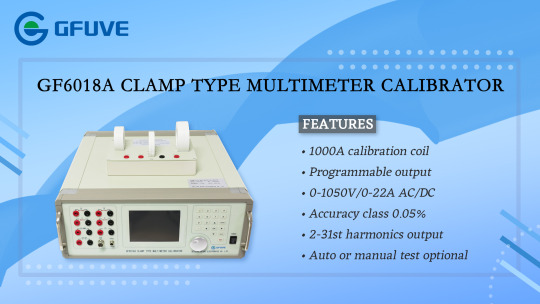
GF6018A High precisition 6.5bit portable AC DC multi product calibrator for multimeter calibrator
This GF6018A high precision multi-product calibrator is compliance with national verification regulation: JJG124-2005 Ammeter, voltmeter, power meter and resistance meter verification rules" and related national standards. 0.05% single-phase standard AC/DC voltage and current source, can verify level 0.2 and the following AC/DC voltmeter, ammeter, frequency meter, resistance meter & clamp meter. The source signals by using DSP and 16-bit high-speed A/D converters of controllable sine wave, the distorted wave signal source. Multifunction calibrator GF6018A is designed as universal calibration tool for electrical calibration laboratories. Measurement range from 0-1050V and 0-20A AC/DC;With 200A, 600A, 1000A calibration coil.
The GF6018A clamp type multimeter calibrator with RS-232 port, it can be connected with PC to control, become automatic verification system. It has precise interface and multi-functions including verification, storage and query. The GF6018A multimeter calibrator adopts color LCD screen, chart character display is clear, with high precision, stable and reliable, convenient operation and flexible characteristics. It fully meets ISO17025 laboratory standards and is a good ideal test equipment for electrical engineers.
APPLICATION
■ Power plant;
■ Universities;
■ Panel manufacturer;
■ Research institutes;
■ Electrical testing center;
■ Multimeter manufacturers;
■ Oscilloscope manufacturer;
■ Clamp meter manufacturers;
■ Digital meter manufacturers;
■ ISO17025 Electrical laboratory;
■ Electricity power bureau & power company;
■ Power engineering commissioning company;
■ Electrical Department of industrial and mining enterprises;
1 note
·
View note
Text
From Voltage to Resistance: The Complete Spectrum of Measuring Instruments
When it comes to electrical engineering and testing, having the right measuring instruments is essential. From measuring voltage and current to resistance and beyond, a comprehensive set of instruments is crucial for accurate and reliable results. Let's explore the complete spectrum of measuring instruments available:
Voltage Measurement
Voltage is one of the fundamental parameters in electrical systems, indicating the electrical potential difference between two points. Voltage measuring instruments, such as digital multimeters (DMMs) and voltmeters, allow engineers to measure voltage levels accurately. Whether testing circuits, batteries, or power supplies, voltage measurement instruments provide valuable insights into the electrical characteristics of a system.
Current Measurement
Current measurement is essential for understanding the flow of electrical charge within a circuit. Ammeters and current probes are commonly used instruments for measuring current. By accurately measuring current levels, engineers can ensure that circuits are operating within specified parameters and identify potential issues such as overloads or short circuits.
Resistance Measurement
Resistance is a measure of how much a material opposes the flow of electrical current. Resistance measuring instruments, such as ohmmeters and resistance decade boxes, allow engineers to determine the resistance of components, wires, and circuits. By measuring resistance accurately, engineers can troubleshoot circuitry, verify component values, and ensure proper functionality.
Capacitance Measurement
Capacitance is the ability of a component to store electrical charge. Capacitance measuring instruments, such as capacitance meters and LCR meters, are used to measure the capacitance of capacitors and other components accurately. Capacitance measurement is crucial for verifying component values, testing capacitance in circuits, and diagnosing issues related to capacitive coupling.
Inductance Measurement
Inductance is the property of a component to oppose changes in current flow. Inductance measuring instruments, such as inductance meters and LCR meters, allow engineers to measure the inductance of coils, transformers, and other components accurately. Inductance measurement is vital for designing and testing circuits involving magnetic fields and inductive components.
Frequency Measurement
Frequency is the number of cycles per second in an alternating current (AC) signal. Frequency measuring instruments, such as frequency counters and oscilloscopes, enable engineers to measure the frequency of electrical signals accurately. Frequency measurement is essential for analyzing AC circuits, troubleshooting signal integrity issues, and verifying oscillator performance.
Temperature Measurement
Temperature measurement is critical for monitoring the thermal characteristics of electrical components and systems. Temperature measuring instruments, such as thermocouples and infrared thermometers, allow engineers to measure temperature accurately in various environments. Temperature measurement is essential for preventing overheating, optimizing thermal management, and ensuring system reliability.
Power Measurement
Power measurement is essential for evaluating the energy consumption and efficiency of electrical systems. Power measuring instruments, such as power analyzers and wattmeters, enable engineers to measure voltage, current, and power levels accurately. Power measurement is crucial for assessing energy usage, optimizing power distribution, and verifying system performance.
Advanced Measurement Techniques
In addition to basic electrical parameters, advanced measurement techniques such as impedance spectroscopy, harmonic analysis, and transient response testing are used to characterize complex electrical systems accurately. These techniques provide deeper insights into the behavior and performance of circuits, components, and systems.
Conclusion
From voltage to resistance, the complete spectrum of measuring instruments plays a vital role in electrical engineering and testing. By employing the right instruments and techniques, engineers can ensure the accuracy, reliability, and performance of electrical systems in various applications. Whether designing circuits, troubleshooting issues, or verifying specifications, having access to a comprehensive set of measuring instruments is essential for success in the field of electrical engineering.
0 notes
Text
1pc Smart Digital Multimeter - Auto-ranging Voltmeter, Electrical Tester for Voltage, Current, Capacitance, Resistance, Continuity, Duty-cycle, Temperature, and Frequency
👉 -7% off discount+EXTRA 30% OFF❤️
🎉 Coupon price[$15.99] -7% off
👉 item link: https://temu.to/m/uohqq0qczg9

#love#instagood#fashion#photography#photooftheday#beautiful#art#nature#travel#picoftheday#home#men#women
0 notes
Text
The Evolution of Electrical Measuring Instruments
Electrical measuring instruments have undergone a remarkable evolution over the years, shaping the way we understand and interact with electrical systems. At Power Tech Electric, we recognize the significance of this evolution and its impact on various industries. Join us as we explore the fascinating journey of electrical measuring instruments, from their humble beginnings to the sophisticated tools we rely on today.
Early Developments
The history of electrical measuring instruments dates back to the 19th century when pioneers like André-Marie Ampère and Georg Simon Ohm laid the foundation for modern electrical theory. Early instruments such as galvanometers and voltmeters provided basic measurements of electrical current and voltage, paving the way for further advancements in the field.
Industrial Revolution
The Industrial Revolution of the late 19th and early 20th centuries spurred rapid advancements in electrical engineering and instrumentation. Innovations like the electromechanical wattmeter and the mercury arc rectifier revolutionized power measurement and control, enabling the widespread adoption of electric power in industrial applications.
Electronic Era
The mid-20th century saw the emergence of electronic measuring instruments, ushering in a new era of precision and accuracy. Devices like the oscilloscope, digital multimeter, and spectrum analyzer revolutionized electrical measurement, offering greater sensitivity, speed, and functionality than ever before. These advancements paved the way for breakthroughs in fields such as telecommunications, electronics, and automation.
Integration of Technology
In recent years, the integration of technology has transformed electrical measuring instruments into sophisticated, intelligent devices. Modern instruments are equipped with features such as digital displays, wireless connectivity, and advanced data analysis capabilities, allowing for real-time monitoring, remote operation, and predictive maintenance. These advancements have revolutionized industries ranging from power generation and distribution to renewable energy and smart grid systems.
Future Trends
Looking ahead, the future of electrical measuring instruments promises even greater innovation and advancement. Technologies such as artificial intelligence, machine learning, and Internet of Things (IoT) are poised to reshape the landscape of electrical measurement, enabling autonomous systems, predictive analytics, and enhanced decision-making capabilities. As the demand for energy efficiency, sustainability, and reliability continues to grow, electrical measuring instruments will play a crucial role in shaping the future of electrical engineering and beyond.
Conclusion
The evolution of electrical measuring instruments is a testament to human ingenuity, innovation, and progress. From humble beginnings to cutting-edge technologies, these instruments have played a vital role in advancing our understanding of electricity and shaping the modern world. At Power Tech Electric, we are proud to be part of this journey, providing industry-leading electrical measuring instruments and solutions to meet the evolving needs of our customers. Visit Power Tech Electric to explore our range of high-quality instruments and join us in shaping the future of electrical measurement.
0 notes
Text
Tester Baterai Digital Voltmeter Analyzer 12V Taffware - CNBJ-805
0 notes
Text

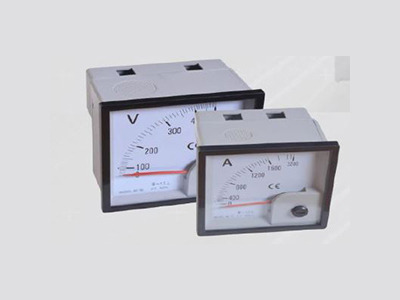
Energy Measurements
We are specialized in low voltage measurement devices. Our product portfolio is growing all the time according to the leading standards, ensuring accurate and safe measurement instruments are our primary objective and a crucial element in achieving progress and prosperity. We are there to help you across the globe and to offer you advice & information about our range of products. In addition, we work with you to develop the best possible solutions for your specific requirements.
Digital Meters & Relay
Digital Meters & Relays are devices to measure and control electrical parameters such as Power Factor Relays, Mustimeters & Energy Analysers.
1. 3-phase voltage and 3-phase current transformer ratio entry.
2. It shows voltage (V), current (C), frequency (F).
3. It shows current values (I1, I2, I3) of each phase at the same time.
4. Phase sequence alarm LED
Optional
• RS485 Modbus RTU (1200 – 38400bps)
• 75 x 65 Custom Design Glass LCD 3 Menu is password-protected.
• 3 – phase voltage and 3 – phase current transformer ratio entry.
Optional
• Apparent power (S), minimum (min), maximum (max) and mean values of phase-to-neutral and phase-to-phase.
• It shows current values (I1, I2, I3) of each phase at the same time.
• Relay output (adjustable)
• Current (C) and apparent power (S) demand values of phase-to-neutral and phase-to-phase.
• You can delete the demands.
• It has voltage, Currents and Frequency protections
Voltmeter and Ammeter Selectors
Voltmeter and Ammeter Selectors are designed to choose which Voltage and Which Current Parameters to be displayed on the connected Meter.
Analog Voltmeter & Ammeter
Analog Voltmeter & Ammeter suitable for transformer ratios from 15/5A to 5000 /5A AC. Scales are changeable.
There are different dimensions for the AMMETER and VOLTMETER as following:
AMMETER 72×72 mm
VOLTMETER 72×72 mm
AMMETER 96X96 mm
VOLTMETER 96X96 mm
Current Transformers
Current Transformers have Primary currents from 40A to 5000A AC; available in secondary current 1A or 5A AC; 0.5, 1.0 or 3.0 accuracy class.
Window-type current transformer with sealable terminal cover, suitable for primary currents from 40A to 5000A AC; available in 1A or 5A AC secondary current; 0.5, 1.0 or 3.0 accuracy class. Fixing apparatuses are available for DIN rail and on surface fixing.
0 notes
Text
Revolutionizing Connection Technology with Plug & Socket Terminal Block Spring Clamp
Elmex is a leading name in the field of electrical connection technology, and their plug and socket terminal block spring clamps are one of their most innovative offerings. These spring clamps have revolutionized the way electrical connections are made, providing a secure and reliable connection that is easy to install and maintain.
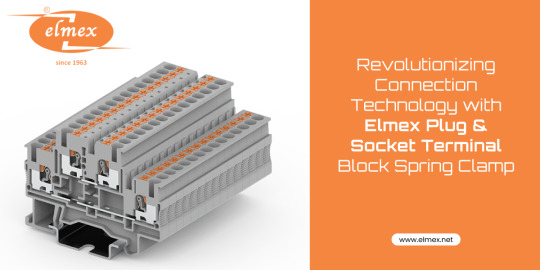
One of the key advantages of Elmex plug and socket terminal block spring clamps is their ease of use. Unlike traditional screw terminals, which require manual tightening and loosening, these clamps use a spring mechanism to create a tight, secure connection with minimal effort. This makes installation and maintenance much faster and more efficient, which is especially important in large-scale industrial applications.
Another advantage of Elmex plug and socket terminal block spring clamps is their reliability. The spring mechanism ensures a consistent level of contact pressure, which minimizes the risk of loose or intermittent connections. This is particularly important in applications where the connection must remain stable and secure over a long period of time, such as in power distribution systems.
Elmex plug and socket terminal block spring clamps are also highly versatile. They can be used with a wide range of wire sizes and types, making them suitable for a variety of applications. In addition, they can be easily mounted on a DIN rail or panel, providing flexibility in installation.
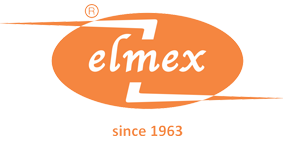
Elmex plug and socket terminal block spring clamps are also designed with safety in mind. They are made from high-quality, flame-retardant materials that meet industry safety standards. This ensures that they can be used in even the most demanding environments without compromising safety.
In conclusion, Elmex plug and socket terminal block spring clamps are a game-changer in the field of electrical connection technology. Their ease of use, reliability, versatility, and safety make them an ideal choice for a wide range of industrial and commercial applications. If you are looking for a secure and efficient way to make electrical connections, Elmex plug and socket terminal block spring clamps are the way to go.
#Plug & socket terminal block spring clamp#Micro terminal block spring clamp#Panel mounted terminal blocks spring clamp India#Component housing block spring clamp#Spring loaded terminal blocks#spring loaded terminal connector#spring type terminal block#solar pv panel junction box India#solar pv branch connector India#electrical wire termination technology#manufacturer#DIN Rail Mounted Connectors#switchgear industry#solar product#PCB connectors#digital voltmeter#digital ammeter#power and signal#current transformer#renewable energy#electrical company
4 notes
·
View notes